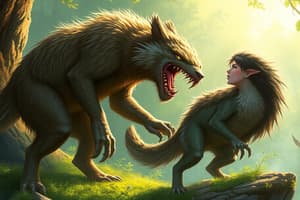Podcast
Questions and Answers
Which of the following interactions is classified as mutualism?
Which of the following interactions is classified as mutualism?
- Competition
- Predator-prey interaction
- Parasitism
- Commensalism (correct)
What distinguishes ectoparasites from endoparasites?
What distinguishes ectoparasites from endoparasites?
- Ectoparasites live externally on their host. (correct)
- Ectoparasites are always larger than endoparasites.
- Ectoparasites cause more severe harm.
- Ectoparasites require a different host for reproduction.
In what type of interaction do two species have a negative effect on each other?
In what type of interaction do two species have a negative effect on each other?
- Competition (correct)
- Amensalism
- Commensalism
- Mutualism
Which of the following is an example of an endoparasite?
Which of the following is an example of an endoparasite?
Which type of herbivory refers to the consumption of grasses and herbs?
Which type of herbivory refers to the consumption of grasses and herbs?
What is an example of a structural plant defense?
What is an example of a structural plant defense?
What kind of mimicry occurs when non-toxic animals imitate the color patterns of toxic animals?
What kind of mimicry occurs when non-toxic animals imitate the color patterns of toxic animals?
Which of the following is a chemical defense mechanism found in plants?
Which of the following is a chemical defense mechanism found in plants?
What type of coloration helps an organism blend into its environment to avoid detection?
What type of coloration helps an organism blend into its environment to avoid detection?
Which of these describes a defense mechanism that occurs as a reaction to herbivory?
Which of these describes a defense mechanism that occurs as a reaction to herbivory?
What phrase summarizes the concept of warning coloration in animals?
What phrase summarizes the concept of warning coloration in animals?
What is the goal of camouflage in terms of predator avoidance?
What is the goal of camouflage in terms of predator avoidance?
What type of mimicry involves two harmful species resembling each other?
What type of mimicry involves two harmful species resembling each other?
What does the symbol +/+ represent in interspecific interactions?
What does the symbol +/+ represent in interspecific interactions?
What type of competition involves individuals of the same species?
What type of competition involves individuals of the same species?
Which type of mutualism involves a partner defending another in exchange for food or shelter?
Which type of mutualism involves a partner defending another in exchange for food or shelter?
In exploitative competition, what resource is primarily depleted?
In exploitative competition, what resource is primarily depleted?
What is an example of trophic mutualism?
What is an example of trophic mutualism?
Which interaction would be characterized as -/-?
Which interaction would be characterized as -/-?
What is a key characteristic of cleaning mutualism?
What is a key characteristic of cleaning mutualism?
Which species interaction is described as +/0?
Which species interaction is described as +/0?
Flashcards
Interspecific Interactions
Interspecific Interactions
Interactions between different species
Consumer-Resource Interaction
Consumer-Resource Interaction
One species consumes another (e.g., predator-prey, parasite-host)
Parasitism
Parasitism
One organism (parasite) benefits at the expense of another (host), often symbiotic but not always lethal
Herbivory
Herbivory
Signup and view all the flashcards
Seed Predator (Granivore)
Seed Predator (Granivore)
Signup and view all the flashcards
Predator Avoidance
Predator Avoidance
Signup and view all the flashcards
Cryptic Coloration
Cryptic Coloration
Signup and view all the flashcards
Aposematic Coloration
Aposematic Coloration
Signup and view all the flashcards
Plant defense mechanisms
Plant defense mechanisms
Signup and view all the flashcards
Mullerian Mimicry
Mullerian Mimicry
Signup and view all the flashcards
Batesian Mimicry
Batesian Mimicry
Signup and view all the flashcards
Constitutive Plant Defense
Constitutive Plant Defense
Signup and view all the flashcards
Induced Plant Defense
Induced Plant Defense
Signup and view all the flashcards
Interspecific Interactions
Interspecific Interactions
Signup and view all the flashcards
Competition (Interspecific)
Competition (Interspecific)
Signup and view all the flashcards
Exploitative Competition
Exploitative Competition
Signup and view all the flashcards
Interference Competition
Interference Competition
Signup and view all the flashcards
Mutualism (Trophic)
Mutualism (Trophic)
Signup and view all the flashcards
Mutualism (Defensive)
Mutualism (Defensive)
Signup and view all the flashcards
Mutualism (Dispersive)
Mutualism (Dispersive)
Signup and view all the flashcards
Trade-off (Energy/Resources)
Trade-off (Energy/Resources)
Signup and view all the flashcards
Study Notes
Interspecific Interactions
- Interspecific interactions can be categorized by their effect on each species
- +/-: Consumer-Resource (e.g., predator-prey, parasite-host, parasitoid-host, herbivore-plant, grazing vs. browsing, seed predator)
- -/-: Competition
- +/+: Mutualism
- +/0: Commensalism
- -/0: Amensalism
Consumer-Resource
- Predator-prey
- Parasite-host
- Parasitoid-host
- Herbivore-plant
- Grazing vs. browsing
- Seed predator
Predation
- Predation is a consumer-resource interaction where one organism hunts and consumes another -Examples include images of a bird of prey with caught fish and a snake with a frog in its mouth
Parasitism
- Parasitism is a consumer-resource interaction in which one organism (parasite) harms another (host) without immediately killing it.
- Often symbiotic
- Symbiosis means two species live in close physical association
- Ectoparasite: lives externally on the host's body surface or outside the host's body
- Endoparasite: lives inside tissues of the host
- Parasitism differs from predation as it does not kill the host (e.g., flu/ viruses)
- Examples of blood-consuming human parasites:
- Free-living: mosquitoes, leeches, ticks
- Symbiotic: fleas, lice, malaria.
- Tapeworm life cycle: Cysts in raw meat; larvae form in muscle tissue; eggs hatch to larva and infect animal muscle; Adult tapeworm(8-11ft) in the small intestine; tapeworm head (scolex) attaches to intestine; Eggs contaminate vegetation, ingested by livestock
Parasitoid
- Parasitoid: Insect whose larvae consume and kill the host (e.g., Nasonia etc.)
- Tarantula hawk (Pepsis spp.)
Herbivory
- Grazing: grass/herbs
- Browsing: woody vegetation
- Is the plant-animal version of what?
Seed Predator (Granivore)
- Example: chipmunk eating a nut, toucan eating a seed
Defensive Mechanisms
- Ways to avoid predation:
- Early detection and swift escape
- Camouflage (crypsis)
- Chemical defense (animals and plants)
- Protection: spines (porcupine), thorns (plants)
- Warning coloration (aposematic)
Predator Avoidance Costs
- Studies (graphs) on the costs of predator avoidance for bullfrog tadpoles
- These costs include: Time spent not feeding, growth rates
Cryptic Coloration
- Crypsis: Camouflage (examples: insects, lizards, plants, lithops)
Western Coral Snake
- Picture of the snake.
- Aposematic warning coloration (bright colors warning of toxicity)
Mullerian Mimicry
- Poisonous animals mimic each other's color patterns
- Examples include the pictures of wasps, honeybees, yellow jackets
- What kind of interaction is this?
- There's a study on poison dart frogs of Northern Peru
Batesian Mimicry
- Non-toxic animals mimic the color patterns of toxic or dangerous forms
- Examples include pictures of a wasp, mantis, and a moth
- What kind of interaction?
Plant Defense
- Structural: Spines, bark
- Chemical: Secondary compounds not directly related to metabolism/photosynthesis
- Lignin (indigestible)
- Morphine, nicotine (poison)
- Latex (poison/ gum up mouthparts)
- Examples of studies on milkweed, effects of herbivores on plants
Constitutive vs. Induced Plant Defense
- Constitutive: Always produced
- Induced: Occur after defoliation
Competition
- Intraspecific: Individuals of the same species
- Interspecific: Individuals of different species
- Interference: Direct interaction (physical aggression, territorial fights)
- Exploitative: Depleting shared resources (e.g., bats, hummingbirds, and nectar)
Mutualism
- Trophic: Complementary ways of receiving food (e.g., cows and cellulose, giant tubeworms and bacteria)
- Defensive: Defend each other; Example: cleaning mutualism (removes parasites from fish)
- Dispersive: Transport pollen or seeds (e.g., honeyguides and humans) -Seed dispersal benefits?
Commensalism
- Antbirds and Army ants
- Remora (suckerfish)
- Epiphytes (e.g., orchids, bromeliads)
Amensalism
- Example of fungus (Penicillium) affecting bacterial growth.
Studying That Suits You
Use AI to generate personalized quizzes and flashcards to suit your learning preferences.




